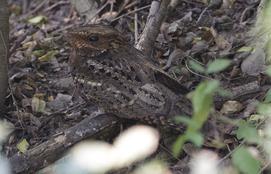CHUCK-WILL'S-WIDOW IL-127
Southern Illinois: Shawnee National Forest
June 4, 4:55 a.m.
Sunrise at 5:33 a.m.
Two chuck-will's-widows, the same two who dueled here last night, counter each other with their chuck-WILL'S-WID-ows. Both birds call loudly at first, and then the near bird moves off (at 0:43), to resume singing off to the side about ten seconds later. One bird croaks for a bit, beginning about 2:25, ending with a sighing growl at 2:52. That's what one hears on the first pass.
But notice the subtle differences in their voices, best heard when the two birds alternate their songs beginning at 0:19. The more distant bird at this time hustles through his song, but the near bird feels more deliberate, and his song is in fact about 15% longer. Now that you can hear the differences in the songs, you can know which bird is which as they move about.
What one learns by listening to these two chuck-will's-widows as individuals is that the bird who is initially more distant seems to be the constant in this recording, suggesting that it is he who owns the territory and the other bird is the visitor. The bird who sings first here (at 0:01, the "far bird" who hustles through his song) is the same bird who remains singing at the end, as determined by the individual distinctiveness of his song. It is the other bird who moves about, first very near, then off to the side, and it is he who growls and sighs while the more consistent singer, most likely the resident, carries on.
Background
In the predawn, insects continue to rule; an indigo bunting offers a single song from his night roost (3:01), followed soon by a northern cardinal warming up with abbreviated songs (beginning at 3:32).

Photo by Brian L. Sullivan
